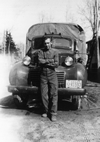13. Abundance
SERAFINO AND MARIA were delighted. Life on Lehigh Row seemed much better than life in Farindola. An easy walk to work and an honest day’s wages earned Serafino enough money to feed a family. Maria didn’t need to toil in any backbreaking fields. She could work exclusively around the house and garden.
Everything seemed to flourish on Lehigh Row. Maria had arrived just in time for her spring planting of potatoes, tomatoes, peppers, and cucumbers. Morning glories, hollyhocks, and lilacs covered the post-and-wire fences around the gardens during the summer. Strawberries, gooseberries, tiger lilies, bleeding hearts, violets, jack-in-the-pulpits, and johnny jump-ups grew wild in the nearby woods. The kids of Lehigh Row picked the berries, dug up the flowers, and brought them home.
Serafino built an arbor against the side of his porch and strung wild grapes that he had found growing like currants in the bushes. The wild grapes proved far too sour for a good wine. So he blended them with raisins from the store, and that did the trick. The finished wine was vigorous yet smooth. “Kind of like myself,” he raised a glass in salute, admiring the rich burgundy color. Lehigh Row began to feel like home.
Serafino and Maria felt that fortune was surely smiling upon them when the outbreak of World War I cast a pall over Europe just four months after their arrival in America. Maria was six months pregnant on that date of July 28, 1914.
Three months later, in the downstairs bedroom of their home on Lehigh Row, Serafino single-handedly assisted Maria in giving birth to their first child, a daughter. The baby girl, named Ida, was born on October 25, mercifully safe as an American citizen sheltered in the American heartland.
“Her life will be so much better in this country!” an exhausted Maria looked up from her maternity bed and paid Serafino the ultimate compliment.
He looked down upon her appreciative eyes, bent down toward her moistened cheeks, and smothered her face in kisses.
The newborn Ida gained two sisters in quick succession: Mafalda in 1915 and Leonata in 1917. The Di Gregorio family grew alongside the other burgeoning Czech, Greek, Hungarian, Italian, Mexican, Polish, and Serbian immigrant families who also called Lehigh Row home.
